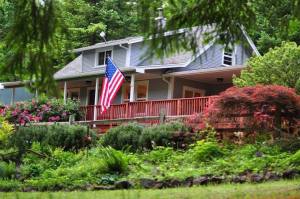Even though I now live in Texas, this house, which sits among the trees and forest, will always be my home. Oregon, especially where I come from, is a plethora of flora and fauna. It is always bursting with color and a variety of sources when it comes to natural dyeing.
This is the tree.
For as long as I can remember, this black walnut tree has stood in this very place. It’s leaves provide shade, and it’s sturdy branches hold a solitary tire swing.
There have been many days in the past, spent swinging in the swing. We would swing so high that our toes would graze the tips of the leaves. It is a beautiful sight to see the golden sun shining through the green leaves of the black walnut tree. Every one of our children have had turns swinging as high as they could go.
But what does this tree have to do with yarn? Well, once again this tree has provided something useful to us.
This is a picture of a black walnut shell. Growing up we always called them ‘pig noses’. But before they could get to the pig nose stage, each black walnut is covered in a thick husk. We would pick the husks up and get all sorts of black and brown juices on our hands that wouldn’t come off. It was a nuisance when I was younger, but now I can see great value in those naturally staining substances! So now I bet you know where I am going with this one!
Inside the husks is a pith of fibrous black substance that surrounds the walnut shell. To create the dye, the whole walnut (husk and all) is put into a bucket and is left to soak for several days. After multiple straining, the left over dye from the walnuts are made into a hot bath for the yarn. The great thing about black walnuts, is the fact that they contain their own tannin. That means NO mordant needed! This is why they stained our fingers growing up.
I am so delighted to introduce to YOU, our brand new line of naturally dyed skeins of yarn. The first batch is dyed with those organic black walnuts from my beloved home in Oregon. The browns are very soft, and variegated between dark and light.
There are 4 skeins available at the time of this blog post. 2 on Comal Sock, and 2 on San Antonio Sock. These are super special and will be a limited supply each time.
I hope to offer you more of these gorgeous naturally dyed yarns, featuring other spectacular natural resources from my home in Oregon.






